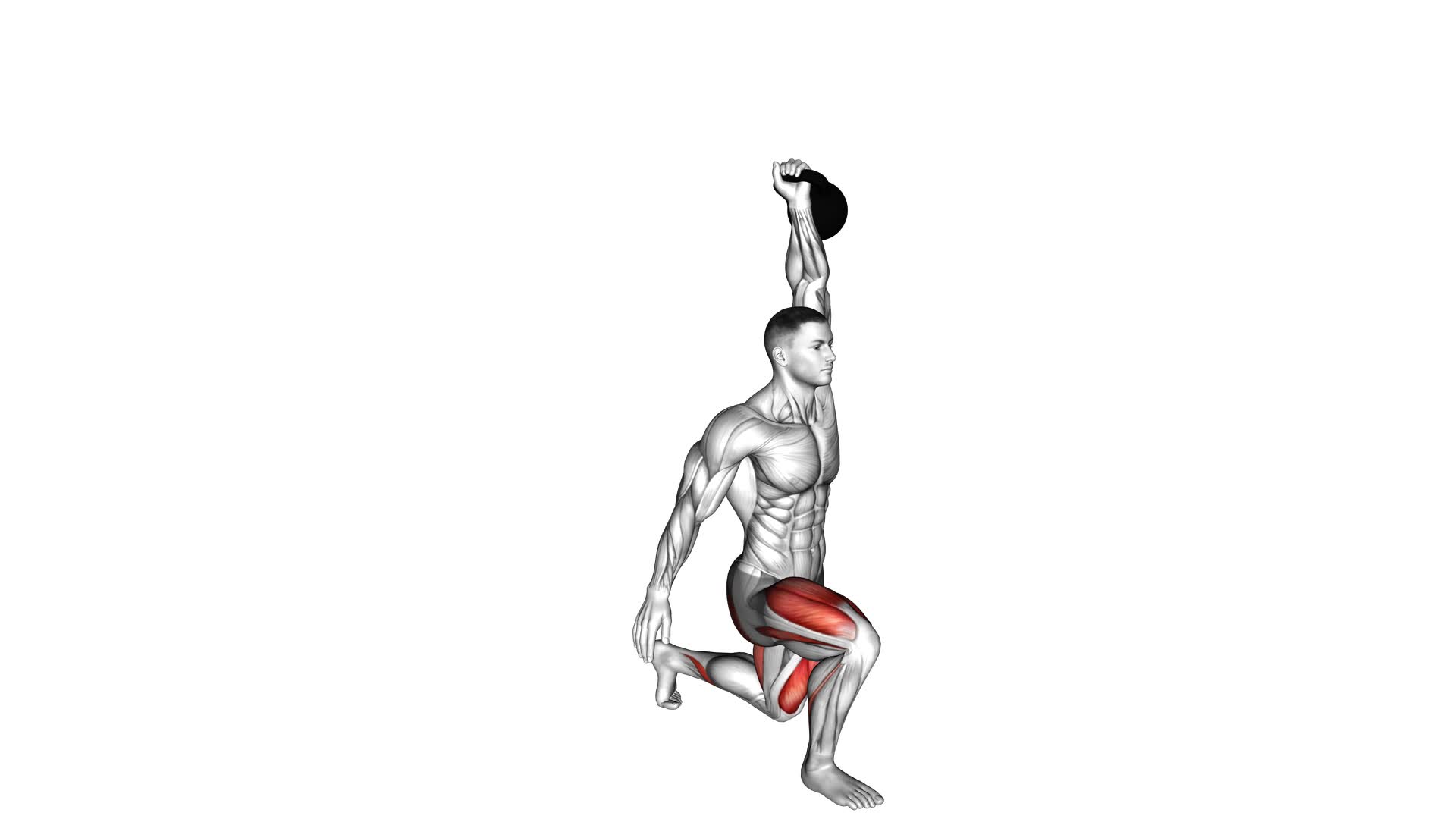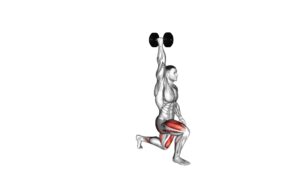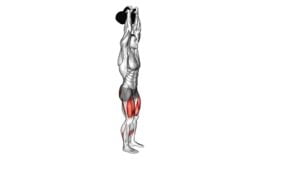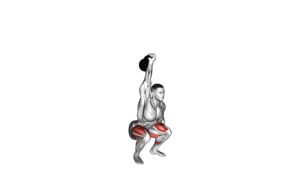Kettlebell Single Arm Overhead Lunge – Video Exercise Guide & Tips

Looking to take your fitness routine to the next level? Check out the Kettlebell Single Arm Overhead Lunge! This dynamic exercise engages multiple muscle groups, improving strength, stability, and balance.
Watch This Exercise Video
In this video exercise guide, we'll walk you through proper technique, common mistakes to avoid, and variations to keep you challenged. Whether you're a beginner or a seasoned fitness enthusiast, incorporating this exercise into your workout routine will help you achieve your goals.
Let's get started!
Key Takeaways
- Targets multiple muscle groups
- Improves balance and core strength
- Engages core muscles for stability
- Maximizes workout efficiency
Benefits of the Kettlebell Single Arm Overhead Lunge
One of the key benefits of performing the Kettlebell Single Arm Overhead Lunge is that it effectively targets multiple muscle groups, allowing you to maximize your workout. This exercise is particularly beneficial for improving balance and core strength.
By engaging your core muscles to maintain stability while performing the lunge, you're effectively strengthening your core muscles. Additionally, the unilateral movement of the exercise, using only one arm to hold the kettlebell overhead, requires you to engage your core muscles even more to maintain proper form and balance. This helps to improve your overall balance and stability.
Incorporating the Kettlebell Single Arm Overhead Lunge into your workout routine can be highly beneficial for those looking to strengthen their core and improve their balance. It's a challenging exercise that engages multiple muscle groups simultaneously, making it a highly effective exercise for maximizing your workout.
Proper Technique and Form
To perform the Kettlebell Single Arm Overhead Lunge with proper technique and form, you should start by holding a kettlebell in one hand above your head. Here are some tips to ensure you're doing it correctly:
- Maintain proper posture: Stand tall with your chest up, shoulders back, and core engaged. This will help you stabilize the kettlebell overhead and maintain balance throughout the lunge.
- Step forward: Take a controlled step forward with your opposite leg, keeping your knee in line with your ankle. Descend into the lunge by bending both knees, ensuring that your back knee hovers just above the ground.
- Overhead stability: Keep the kettlebell directly above your head throughout the movement. Make sure your arm is fully extended and your wrist is neutral to avoid any strain.
Exercise Modifications:
- Beginners: If you're new to this exercise or lack the necessary strength and stability, you can start by using a lighter kettlebell or even a dumbbell. Focus on perfecting your form and gradually increase the weight as you progress.
- Advanced: To add an extra challenge, you can try performing the lunge on an unstable surface like a BOSU ball or by adding a rotational twist at the bottom of the lunge.
Equipment and Setup
Now let's explore what equipment you'll need and how to set up for the Kettlebell Single Arm Overhead Lunge.
For this exercise, you'll need a kettlebell of a suitable weight for your fitness level. The weight should challenge you, but still allow you to maintain proper form throughout the exercise. Start by selecting a kettlebell that you feel comfortable with and gradually increase the weight as you become stronger.
To set up for the Kettlebell Single Arm Overhead Lunge, stand with your feet shoulder-width apart and hold the kettlebell in one hand, keeping it close to your chest. Ensure that your back is straight and your core is engaged. Take a step forward with one leg, lowering your body into a lunge position. As you descend, press the kettlebell overhead, fully extending your arm. Once you reach the bottom of the lunge, push up through your front heel to return to the starting position. Repeat the exercise on the other side.
Remember to maintain proper form throughout the exercise and listen to your body. If you experience any pain or discomfort, stop and consult with a fitness professional.
Now you're ready to start your Kettlebell Single Arm Overhead Lunge workout!
Common Mistakes to Avoid
When performing the kettlebell single arm overhead lunge, it's important to be aware of common mistakes that can hinder your progress and increase the risk of injury.
One common mistake to avoid isn't maintaining proper form throughout the exercise. It's crucial to demonstrate the correct technique and alignment to prevent strain on your joints and maximize the effectiveness of the exercise.
Additionally, injury prevention tips should be followed, such as starting with a lighter weight and gradually increasing as you build strength and stability.
Proper Form Demonstration
Avoid the common mistakes and maintain proper form when performing the kettlebell single arm overhead lunge. Follow these proper form tips to ensure you get the most out of this exercise and avoid injury:
- Keep your core engaged: Engaging your core muscles will help stabilize your body and maintain balance throughout the movement.
- Maintain a straight back: Avoid rounding your back and keep your spine aligned from your head to your tailbone. This will help prevent strain on your lower back.
- Step forward with control: Take a controlled step forward with your front foot, ensuring your knee stays in line with your ankle. This will help activate your glutes and quads effectively.
Injury Prevention Tips
To prevent injuries and ensure proper form, it's crucial that you focus on maintaining stability and control throughout the kettlebell single arm overhead lunge. Here are some injury prevention tips to keep in mind.
First, always warm up properly before starting your workout. Engage in dynamic stretches and mobility exercises to prepare your muscles and joints for the movements ahead.
Additionally, pay attention to your body's signals and avoid pushing yourself too hard, especially if you're a beginner. Gradually increase the weight and intensity of the exercise over time.
It's also important to maintain proper alignment and posture throughout the lunge. Keep your core engaged, shoulders back, and chest lifted.
Lastly, listen to your body and take breaks if you start feeling any pain or discomfort.
By following these injury prevention tips, you can minimize the risk of injuries and maximize the benefits of the kettlebell single arm overhead lunge.
Moving on to the next section, let's explore some variations and progressions you can incorporate into your workout routine.
Variations and Progressions
Now let's explore the variations and progressions of the kettlebell single arm overhead lunge.
These variations allow you to challenge yourself at different exercise levels and increase the difficulty by adding more weight.
Additionally, you can target specific muscle groups by modifying your stance or incorporating additional movements.
Different Exercise Levels
Begin by incorporating variations and progressions to challenge yourself at different exercise levels. Here are some exercise modifications and workout modifications you can try:
- Increase the weight: If you find the kettlebell single arm overhead lunge too easy, try using a heavier kettlebell to increase the intensity of the exercise. This will challenge your muscles even more.
- Add a twist: To engage your core and obliques, you can incorporate a twist into the lunge. As you step forward with one leg, rotate your torso towards that side. This will add an extra challenge and work different muscle groups.
- Plyometric lunges: For a more advanced variation, you can turn the exercise into a plyometric movement. Instead of stepping forward, explosively jump from one lunge position to the other. This will increase your power and cardiovascular endurance.
Remember to always listen to your body and progress at your own pace. As you become stronger and more comfortable, feel free to try these variations to keep challenging yourself.
Increasing Weight Difficulty
As you progress in your kettlebell single arm overhead lunge, you can increase the weight to challenge your muscles even further. By adding more weight to the kettlebell, you can increase the resistance and make the exercise more challenging. This will help to build strength and improve your overall fitness level.
As you become more comfortable with the exercise, you can also consider incorporating advanced modifications to further increase the challenge. For example, you can try performing the lunge on an unstable surface, such as a balance board or a Bosu ball. This will engage more muscles and improve your balance and stability.
Remember to always listen to your body and start with a weight that's appropriate for your current fitness level.
Targeting Specific Muscle Groups
To further target specific muscle groups and continue challenging your muscles, you can incorporate variations and progressions into your kettlebell single arm overhead lunge.
Here are three workout modifications that will help increase muscle activation:
- Reverse Lunge: Instead of stepping forward, step backward into a lunge position. This variation will engage your glutes and hamstrings more intensely.
- Front Rack Position: Hold the kettlebell in a front rack position, with the bell resting on your chest. This modification will primarily work your core muscles and upper body.
- Walking Lunge: Instead of performing stationary lunges, take a step forward with each lunge, moving across the room. This progression adds a dynamic element and increases the challenge for your leg muscles.
Incorporating these variations and progressions will help you target specific muscle groups and make your kettlebell single arm overhead lunge workout more effective and engaging.
Tips for Incorporating the Exercise Into Your Workout Routine
Incorporate the kettlebell single arm overhead lunge into your workout routine for an effective full-body exercise. Incorporating lunges into your routine is a great way to target multiple muscle groups, including your glutes, quadriceps, hamstrings, and core. Adding the overhead element to the lunge further enhances the benefits by engaging your shoulder muscles and improving your overall stability.
To incorporate the kettlebell single arm overhead lunge into your workout routine, start by selecting an appropriate weight kettlebell. Begin with a weight that challenges you but still allows you to maintain proper form. Hold the kettlebell in one hand, with your arm extended overhead, and your core engaged.
Step forward with one foot, lowering your body into a lunge position. Ensure that your front knee is directly above your ankle and your back knee is hovering just above the floor. As you lunge, keep the kettlebell stable and your arm extended overhead.
Push through your front heel to return to the starting position, and then repeat the movement on the opposite side. Aim for three sets of 10-12 lunges on each side, gradually increasing the weight as you become more comfortable with the exercise.
Incorporating the kettlebell single arm overhead lunge into your workout routine not only targets multiple muscle groups but also improves your balance and coordination. It's a challenging exercise that can help you build strength and increase overall fitness.
Frequently Asked Questions
How Many Calories Can You Burn by Doing the Kettlebell Single Arm Overhead Lunge?
You can burn a significant number of calories by doing the kettlebell single arm overhead lunge. This exercise is a great way to work multiple muscle groups and increase your heart rate, which leads to calorie burning.
The benefits of kettlebell exercises include improved strength, balance, and cardiovascular fitness. Incorporating this exercise into your workout routine can help you achieve your calorie burning goals while also reaping the many benefits of kettlebell training.
Can the Kettlebell Single Arm Overhead Lunge Help Improve Your Balance?
Yes, the kettlebell single arm overhead lunge can help improve your balance. By performing this exercise, you're challenging your stability and engaging your core muscles.
Unilateral exercises, like this one, have the added benefit of improving balance and coordination as you're working one side of your body at a time.
Incorporating this exercise into your routine can lead to better overall balance and increased stability.
Is It Safe to Perform the Kettlebell Single Arm Overhead Lunge if You Have Shoulder Issues?
If you have shoulder issues, it's important to be cautious when performing the kettlebell single arm overhead lunge. This exercise requires stability and mobility in the shoulders.
Instead, focus on alternative exercises that won't strain your shoulders, such as the kettlebell goblet squat or the kettlebell front rack lunge. These exercises can still challenge your lower body while reducing the stress on your shoulders.
Remember to always listen to your body and modify any exercise to suit your individual needs.
Can the Kettlebell Single Arm Overhead Lunge Be Modified for Beginners?
When starting out with the kettlebell single arm overhead lunge, it's important to consider beginner modifications and variations for different fitness levels. By modifying the exercise, you can make it more accessible for beginners.
It's crucial to start with lighter weights and focus on proper form and technique. Gradually increase the weight and intensity as you gain strength and confidence.
Remember to listen to your body and adjust the exercise to your fitness level.
How Often Should the Kettlebell Single Arm Overhead Lunge Be Included in a Workout Routine for Optimal Results?
For optimal results, you should include the kettlebell single arm overhead lunge in your workout routine regularly.
This exercise targets multiple muscle groups, including your legs, core, and shoulders.
By incorporating it into your routine, you can improve your overall strength, stability, and balance.
However, it's important to listen to your body and not overdo it.
Start with a frequency that feels comfortable for you and gradually increase as you become more comfortable and proficient with the exercise.
Conclusion
Incorporating the kettlebell single arm overhead lunge into your workout routine can offer numerous benefits. This exercise helps to improve strength, stability, and core engagement. By maintaining proper technique and form, you can avoid common mistakes and maximize the effectiveness of this exercise.
Additionally, variations and progressions can be implemented to challenge your muscles further. This allows you to continuously progress and see improvements in your fitness level. So why not give this dynamic exercise a try and take your fitness to new heights?

Author
Years ago, the spark of my life’s passion ignited in my mind the moment I stepped into the local gym for the first time. The inaugural bead of perspiration, the initial endeavor, the very first surge of endorphins, and a sense of pride that washed over me post-workout marked the beginning of my deep-seated interest in strength sports, fitness, and sports nutrition. This very curiosity blossomed rapidly into a profound fascination, propelling me to earn a Master’s degree in Physical Education from the Academy of Physical Education in Krakow, followed by a Sports Manager diploma from the Jagiellonian University. My journey of growth led me to gain more specialized qualifications, such as being a certified personal trainer with a focus on sports dietetics, a lifeguard, and an instructor for wellness and corrective gymnastics. Theoretical knowledge paired seamlessly with practical experience, reinforcing my belief that the transformation of individuals under my guidance was also a reflection of my personal growth. This belief holds true even today. Each day, I strive to push the boundaries and explore new realms. These realms gently elevate me to greater heights. The unique combination of passion for my field and the continuous quest for growth fuels my drive to break new ground.







